Key takeaways:
- What are key real estate investment strategies? Flipping houses, rental properties, land development, crowdfunding, and syndicates diversify income and investment options.
- Why is a real estate vendor spreadsheet important? It centralizes vendor information, improves communication, increases efficiency, streamlines transactions, and aids budgeting.
- Who is a real estate vendor? Vendors are service providers like inspectors, appraisers, and property managers, essential for smooth real estate transactions.
- What distinguishes a vendor from a vendee? The vendor sells the property, while the vendee purchases it; both must communicate effectively for a successful transaction.
- How can Wrike enhance real estate management? Wrike streamlines project management, automates tasks, centralizes communications, and offers secure access to financial information.
The global economic landscape post-pandemic has been tumultuous, to say the least. With a looming threat of recession and fast-paced technological advancements in artificial intelligence impacting creators, companies, and industries across the board, many are looking to tighten their short- and long-term strategies and create new ways to diversify income and invest profitably.
Real estate has long been considered a solid investment option, offering a myriad of opportunities for established, independent, and collaborative investors. These activities include flipping houses, managing or investing in rental properties, purchasing land for future development, investing in real estate crowdfunding or REITs, and participating in real estate syndicates or joint ventures.
By engaging in intentional learning and joining the right coalitions, you could be on your way to reaping some real estate benefits. However, as inviting as the industry may seem, managing your expectations and planning every step is crucial. It can be easy to lose capital and forget important regulatory compliance tasks that need to be completed for a successful setup.
A real estate vendor spreadsheet helps you create a system for organizing and tracking your real estate work and assets. Using one enables you to stay organized and on top of all your tasks. It also makes it easy to calculate crucial financial metrics, providing valuable insights and a documented history of your performance over time.
This article discusses all you need to know about creating and using a real estate vendor Excel spreadsheet. We’ll share sample templates you can tweak and customize and introduce tools to help you get better at task, time, and resource management.
What is a real estate vendor?
A real estate vendor is a person or a company that provides goods or services to real estate agents and property owners. A vendor can be anyone from a home inspector to a real estate lawyer or landscaper. They are essential to the smooth operation of real estate businesses, providing expertise and specialized skills in various fields.
Real estate vendors play a crucial role in facilitating the home buying, selling, and managing process by offering services such as property inspection, home staging, appraisal, and marketing.
Let’s look at an example. A home inspector is hired by a real estate agent or the potential buyer to assess the condition of a property, identify potential issues, and provide a detailed report of the findings. Then a home stager is hired to improve the look of the house before it’s open for public viewing. Both real estate vendors are crucial in helping the agent and property owner sell and achieve their goals.
In some cases, real estate vendors can act as intermediaries between the property owner and the buyer or tenant. A landlord may hire a property management company or agent to manage the day-to-day business operations of a property, including finding, vetting, and managing buyers or tenants; collecting payment; and handling property maintenance issues.
Vendor vs. vendee in real estate
The relationship between a vendor vs. vendee in real estate refers to the connection of the seller (vendor) and the buyer (vendee) in a real estate transaction. The vendor is the person or entity selling the property and the vendee is the person or entity purchasing the property.
An example of a vendor in a real estate transaction would be an individual looking to move and sell their primary residence. This person would be responsible for setting a price, making a decision on offers from potential buyers, and eventually accepting an offer. They may work with a professional real estate agent, also a vendor in this case, to reach a wider net of potential buyers and effectively tick off all real estate industry compliance without hassle.
On the other hand, an example of a vendee would be a young couple looking to buy their first home. The couple would be responsible for choosing a property that meets their needs and budget, negotiating a price, and making an offer to the vendor.
It’s important to note that the vendor and vendee can both be individuals, as well as corporations, trusts, or other entities. In some cases, the vendor and vendee may be represented by real estate agents or attorneys, acting as intermediaries in the transaction.
A good relationship between vendor and vendee is critical to successfully completing a real estate transaction. Both parties must communicate effectively, understand their rights and responsibilities, and work together to reach a mutually acceptable agreement. This often requires the use of legal contracts, such as purchase and sale agreements and other necessary paperwork for transferring ownership, leases, or management to the other party.
Why is it important to keep a real estate vendor spreadsheet?
A real estate vendor spreadsheet is a useful tool for building and managing a real estate business or project. It is an organized way of tracking crucial information about clients, vendees, and project progress. It helps to streamline resource management, ensuring your time is optimally allocated.
Whether it’s a simple spreadsheet gathering vendees’ names, contact information, property requirements, and budgets or a powerful spreadsheet app or project management software, vendor spreadsheets bring sanity to the process. They make task management easier and collaboration more coordinated, especially in remote teams. Other benefits of real estate vendor spreadsheets include:
- Improved efficiency: Having all vendor information in one place allows real estate agents and property owners to quickly and easily identify which vendor to contact for specific services, saving time and reducing the risk of errors.
- Better communication: A spreadsheet helps real estate agents and property owners keep track of vendor contact information, making it easier to communicate with vendors when necessary.
- Streamlined transactions: A vendor spreadsheet can keep track of the status of various transactions, ensuring that all parties involved are on the same page and that transactions proceed smoothly.
- Improved budgeting: A real estate vendor spreadsheet can help real estate agents and property owners keep track of vendor costs, making it easier to budget for expenses and ensure they stay within their financial constraints.
- Better vendor management: By having a complete record of all vendors involved in a real estate transaction, real estate agents and property owners can more easily evaluate vendor performance, making it easier to identify areas for improvement and develop better working relationships with their vendors.
Examples of real estate vendor spreadsheets
Below, we have a list of examples of real estate vendor spreadsheets you can recreate, tweak, and use in simple spreadsheet software such as Excel or Google Sheets, or even on a piece of paper if that’s your preferred mode of task and progress tracking.
Basic vendor information spreadsheet
A basic vendor information spreadsheet contains information about each vendor working on a property or multiple properties. It serves as one huge address book for all vendors you’ve worked (and are working) with.
It may include the vendor’s name, company name, contact information (phone, email, address), and a brief description of the services they provide.

Vendor services spreadsheet
The vendor services spreadsheet is used to keep track of the various services provided by vendors or contractors. This spreadsheet typically includes vendor names, the type of service they provide, the cost of the service, and any other relevant information.
The spreadsheet may also include a notes section to keep track of any communications with the vendor and a rating system to track the quality of their work. It is a simple tool for property managers and agents to compare vendor services and gather a record of experience with each vendor, which can come in handy for future budget planning and resolving disputes.

Vendor performance spreadsheet
The vendor performance spreadsheet is a tool used by property owners and real estate agents to track and evaluate the performance of vendors. It helps to give insights into which vendor is best for specific projects and the quality of output you can expect from them.
A vendor performance spreadsheet may include columns for the vendor name, date of last service, type of service rendered, quality of service (typically on a scale of one to five), timeliness of service, client satisfaction, and an overall (usually an average) score.

Vendor payment spreadsheet
The vendor payment spreadsheet is used to keep track of vendor payments. It is used by property management companies, landlords, or property owners to track and record payments made to vendors or suppliers.
The spreadsheet typically includes columns for vendor names, invoice numbers, payment dates, payment amounts, and any relevant payment details such as payment method, transaction ID, and check number. It helps ensure that all vendor payments are recorded and tracked accurately, which helps maintain a clear record of all expenses, reducing the risk of payment disputes.

Vendor communication log spreadsheet
The vendor communication log spreadsheet is a document used by property managers to track and log all communication with vendors for a specific property or a group of properties. It is designed to keep track of the date and time of each contact, the type of communication (phone call, email, in-person meeting, etc.), the vendor involved, a summary of the discussion or request made, and any follow-up tasks.
This ensures all vendor interactions are recorded in one place and provides an accessible history of all vendor communications. This can be particularly useful for tracking requests for maintenance and repairs, resolving disputes, and following up on pending tasks and projects. The vendor communication log can also be used to evaluate vendor performance over time and identify areas for improvement in vendor management processes.

Property management spreadsheet
A property management spreadsheet is used by property managers to organize and track important details related to their properties and tenants. It keeps track of tenant data, rental income, property expenses, and lease agreements.
This spreadsheet typically includes other spreadsheets and tables, such as a tenant and vendor information spreadsheet, rent roll tracker, maintenance tracker, and income and expenses spreadsheet. Having all this information in one place makes it easy for property owners and managers to keep track of their properties and make informed decisions about their investments.

Rent roll tracking spreadsheet
The rent roll tracking spreadsheet is a real estate management tool used to track and record the collection of rent from tenants. It includes details such as the tenant’s name, the property address, the monthly rent amount, and any late fees or penalties. The spreadsheet also includes a running total of all rent received, helping property managers or landlords quickly determine if they have received all the rent payments due for a period.
The spreadsheet can be used to identify tenants behind on rent payments and track rent trends over time, allowing property managers or landlords to make informed decisions about rent increases or decreases based on current market conditions.

Maintenance and repairs spreadsheet
The maintenance and repairs spreadsheet is a document that tracks and manages all the maintenance and repair tasks related to rental properties. It is designed to help property managers, landlords, and real estate investors keep track of their properties’ ongoing maintenance needs and expenses.
This spreadsheet typically includes columns for the due date of the repair, a description, the cost, and the name of the vendor or contractor assigned. This enables property managers and landlords to plan and prioritize repairs and keep track of expenses for each property, which is essential for budgeting and cash flow management.
The maintenance and repairs spreadsheet also helps to keep track of the history of repairs for each property, which can be helpful for future decision making.

Tenant management spreadsheet
A tenant management spreadsheet is a tool used by property managers and landlords to keep track of their tenants and rental properties. It typically includes information such as the tenant’s name, contact information, lease agreement details, rent payment history, and any maintenance or repair requests made by the tenant.
This spreadsheet can also be used to evaluate potential tenants before accepting them into your rental property. This may include credit check information, employment verification, and rental history.

Real estate task management spreadsheet
The real estate task management spreadsheet is used by real estate agents and professionals to manage and prioritize their daily tasks. It typically includes columns for the task description, deadline, priority level, status, and notes. It may be categorized based on clients, properties, or specific tasks, e.g., sales, marketing, and showings.
This spreadsheet helps real estate managers and professionals stay organized and complete tasks on time. It is essential for individuals, teams, and collaborators looking to streamline their tasks and work more efficiently.
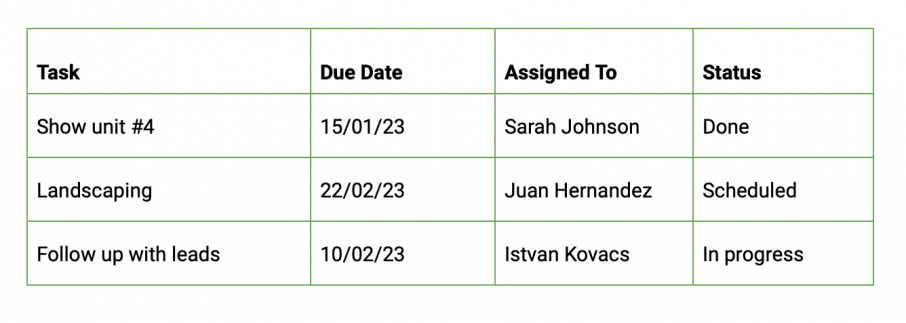
Lease management tracking spreadsheet
A lease management tracking spreadsheet is a tool used by real estate property managers to keep track of their rental properties and the leases associated with them. This spreadsheet typically includes information such as the names of tenants, property addresses, lease start and end dates, rental amounts, security deposit amounts, and other important lease details.
The lease tracking spreadsheet provides a centralized and organized way to manage and monitor leases and their associated income and expenses. It helps property managers ensure that all leases are up to date and in compliance with local laws and regulations.
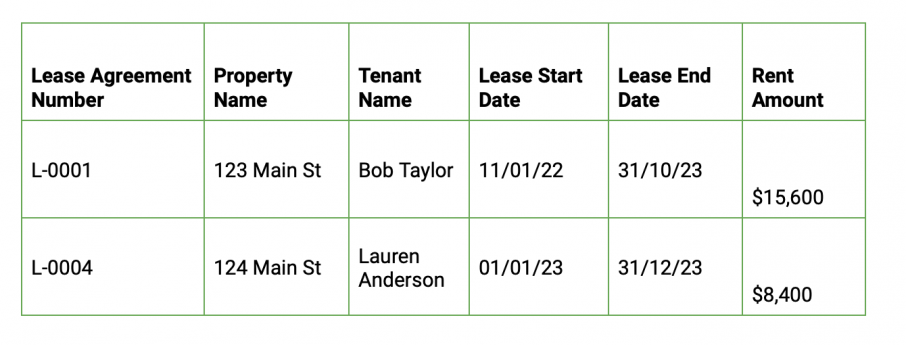
Rental property income and expense tracker
A rental property income and expense tracker monitors the income and expenses associated with a rental property. It is a tool for property owners, investors, and landlords to manage the financial aspect of their properties and record rental income and expenses, including rent receipts, utilities, compliance fees, repairs, and maintenance costs.
With this information, they can calculate and forecast the net income from each period, allowing them to make informed decisions about the property’s finances. Additionally, the tracker can be used for tax purposes, as it provides a comprehensive record of all rental income and expenses. It makes it easy to calculate your profit and loss for a period.
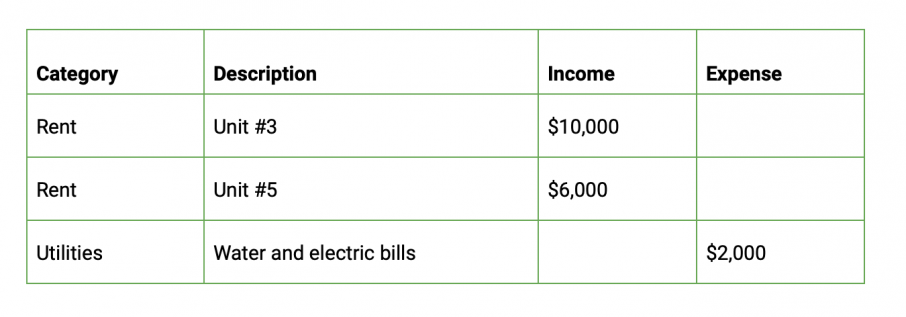
Property management task tracker
A property management task tracker is a spreadsheet or software tool used to keep track of all tasks and activities related to the management of real estate properties. It is used by property managers, landlords, and real estate agents to track tasks such as maintenance and repair requests, rent collection, property inspections, and lease renewals.
A task tracker typically includes columns for the task description, due date, assigned team member, status, and notes. Some task trackers may also have additional columns for priority, budget, and time tracking. This tracker must be updated regularly to reflect the current status of tasks and provide visibility into the progress of property management tasks.

Rental property maintenance tracker
A rental property maintenance spreadsheet is a tool used by property managers or landlords to monitor the maintenance tasks and expenses related to a rental property. It provides a simple and efficient way to track pending and completed maintenance tasks and repairs.
A typical maintenance tracker may include columns for the property number, task description, assigned person, due date, and completion date. Using this tracker ensures that the property is kept in good condition and prevents potential maintenance issues from becoming major problems. It may also include information on the cost of the task and the risk it presents.
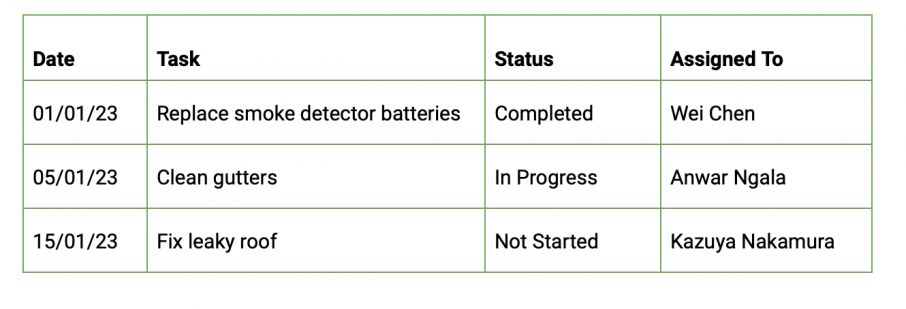
Agent commission tracker
An agent commission tracker is used by real estate professionals to keep track of their commissions earned from the sale or rental of properties. It helps them manage their income and expenses, calculate commissions based on the agreed terms, and keep track of the commissions earned from different clients.
A typical agent commission tracker includes columns for client information, property details, commission rate, and the total commission earned. Some also have columns for expenses incurred during the transaction, such as open house expenses and referral fees.

Property lead tracker
A property lead tracker is a spreadsheet template used to manage and track potential real estate leads for agents, brokers, or investors. It helps keep track of crucial details on potential clients and leads, including property specifications, contact information, the status of the lead, and communication history.
A property lead tracker stores important information in one sheet and ensures that all relevant information is accessible and up to date. It is especially useful for agents looking to expand their client base and close more deals, as it helps them prioritize leads based on specific factors (such as the lead’s budget) and personalize their services to convert leads to clients.
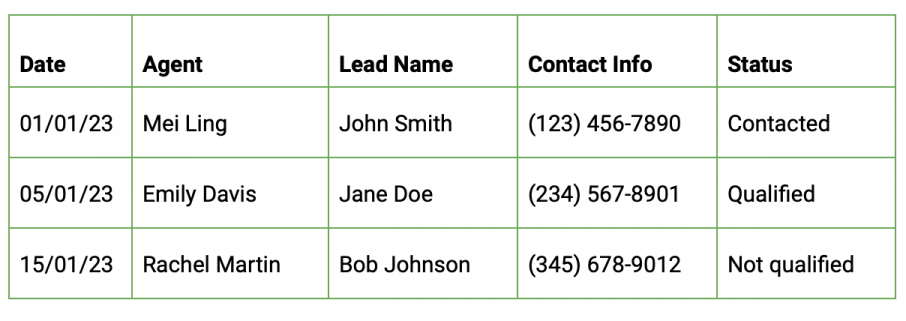
Other types of real estate vendor spreadsheets you can create include:
- Rental application tracking sheet: This template helps property managers keep track of all rental applications, including the applicant’s information, the property applied for, and the status of the application.
- Property budget template: This template is used to create a budget for a rental property, including estimated income and expenses. It helps property managers plan for future investments and repairs.
- Rental inspection checklist: This template is used to perform periodic inspections of rental properties and keep track of any repairs or maintenance tasks that need to be completed. It can be used to document the condition of a property before and after a tenant moves in or out, helping to identify any damages or serve as evidence in case of disputes.
- Maintenance request form: This template documents maintenance requests made by tenants. It can help you monitor requests and ensure they are addressed promptly.
- Tenant screening checklist: This template is used to evaluate potential tenants before accepting them into your rental property. It can include credit check information, employment verification, and rental history.
- Property comparison spreadsheet: This template allows you to compare different properties, including information such as location, rental rates, property expenses, and more. It can help you make informed decisions about which properties to invest in.
These are only a few examples of real estate vendor spreadsheets that can be used to organize and manage vendor information. The specific spreadsheets used may vary depending on the needs of the real estate agent or property owner, but having a centralized and organized system for tracking vendor information is essential for the efficient operation of any real estate business.
The above templates can be customized to suit the specific needs and preferences of the real estate agent or property owner.
Wrike simplifies vendor real estate management
If you’re starting out in real estate or only focused on part of the industry, any one of the vendor templates that can address and close gaps in your processes and workflow would be ideal. You can copy and tweak these templates in Excel or Sheets.
For instance, an independent property manager or small firm can use the property task management template above to keep track of clients, properties, and tasks easily.
However, to scale your business or move even faster, project management software such as Wrike would be a better fit. These robust software platforms facilitate easier management of multiple projects and automate tasks to save you valuable work hours. They enable you to personalize your workspace with custom item types, allowing you to mimic the exact processes of your team and company in a digital workspace.
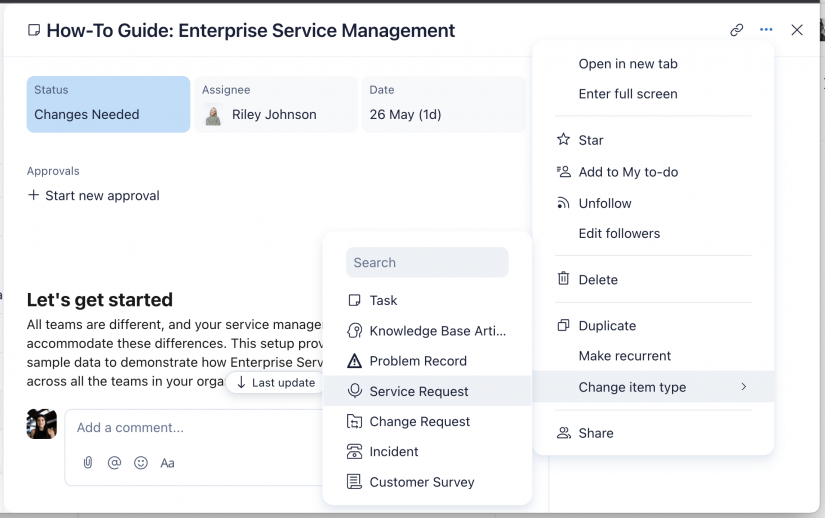
Using Wrike simplifies the process of working with outside collaborators and stakeholders.
- Communications are streamlined with easy @mentions in project-specific spaces
- Notifications are sent to team members automatically once any important changes are made to any projects the team is working on
- In-depth reports showing performance over time are easily generated and shared with specific team members
- The software is highly secure, barring issues such as wrong access to confidential information, e.g., general finances and income details
- It provides a central workspace for many aspects of your business, e.g., task and resource management, project planning, finances, and communication
The benefits of incorporating project management software in your business are many. They pack a punch and help you work faster and more efficiently, keeping up with technological advancements and freeing up time for other work or hobbies.
Are you ready to supercharge your real estate management? Look no further — get started with a free two-week trial of Wrike today.



